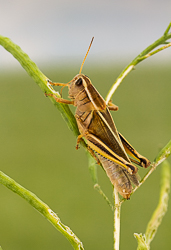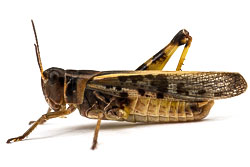| |
 |  |
| The 2017 survey indicates high numbers of grasshoppers were observed primarily in the Peace River Region, north and west of Edmonton and the northern portion of central Alberta across to Saskatchewan.
Investigations in those areas have shown that the most common species present is Melanoplus bruneri. This is a species that wasn’t recognized as a pest until very recently. M bruneri also has documented populations of biennial lifecycle.
This is a possible explanation for the outbreaks in alternate years that have resulted in very wrong forecasts for the past 10 plus years (in the Peace River region and northern central Alberta).
Investigations are underway assess the possibility of this biennial lifecycle and its impact on grasshopper populations. See the past ten years of grasshopper forecasts here. Note that a forecast for a particular year is based on the grasshopper count from the previous August. | |
The rest of the province shows light to low grasshopper populations despite the dry summer in much of southern Alberta. Obviously it will take more than one dry year for the grasshopper populations to recover from their very low levels.
Despite the situation with Melanoplus bruneri, areas indicated with moderate to severe risk could experience problems with grasshoppers if environmental conditions favor the hatching and development of grasshoppers in late May through June. Localized factors such as light soils or south facing slopes result in an elevated risk of grasshopper infestations. Conditions in late spring 2018 will determine the extent of the grasshopper problems later this growing season. Infestation levels in individual fields are NOT indicated in this 2018 Grasshopper Forecast Map.
The 2018 grasshopper forecast map is based on adult grasshoppers counts conducted in early August of 2017 by participating Agriculture Fieldmen across the province. In a new initiative launched in 2017 a modified sampling protocol and training was offered. This should both reduce the workload for Agriculture Fieldmen and increase the accuracy of the forecast. The adult grasshopper counts give an indication of the numbers that are capable of reproduction and egg laying. Environmental factors can result in higher or lower actual populations than forecast. Individual producers need to be aware of the potential risks in their area and monitor fields in order to be prepared to make the appropriate decisions to implement control measures.

Two stripe grasshopper
on canola
Shelley Barkley,
Alberta Agriculture and Forestry |

Clearwing grasshopper
Hind leg removed so wing markings are noticeable
Shelley Barkley, Alberta Agriculture and Forestry |
On individual farms, particular attention should be paid to areas that traditionally have higher grasshopper populations. In addition, grasshoppers tend to lay their eggs near areas of green growth in the fall that will provide potential food sources for emerging young the following spring. Areas with early green plant growth such as field margins, fence-lines and roadsides are also areas that will give early indications of potential grasshopper problems.
If insecticides are needed, note label precautions regarding user safety, proper application techniques and instructions to reduce impacts on non-target organisms. It is important to remember that control measures are intended to protect the crops from economic damage and are never successful in totally eliminating grasshopper populations.
Alberta Agriculture and Forestry acknowledges the commitment and support of the Agriculture Fieldmen across the province in conducting the surveys essential to the creation of this forecast. This survey was coordinated by Alberta Insect Pest Monitoring Network Staff, Alberta Agriculture and Forestry. The data management for this survey was done by Jan Lepp of Alberta Agriculture and Forestry.
Thank you David Giffen, Agriculture and Agri-Food Canada, Saskatoon for building the map.
Printable version of the grasshopper map.
Economic threshold information for grasshoppers.
Frequently Asked Questions
Grasshoppers: Lifecycle, Damage Assessment and Management Strategy
Historic Grasshopper Maps from 2008 to 2017. |
|